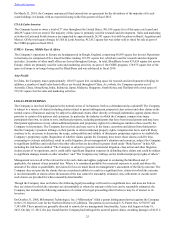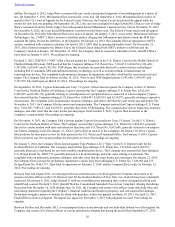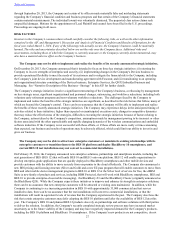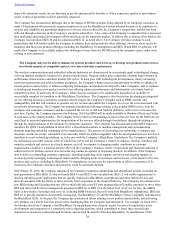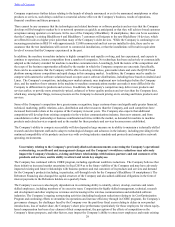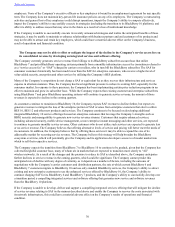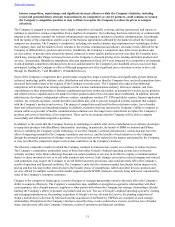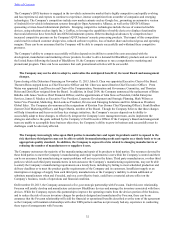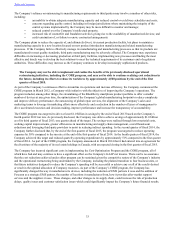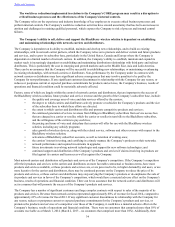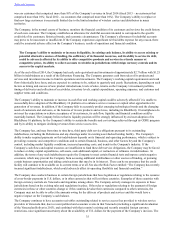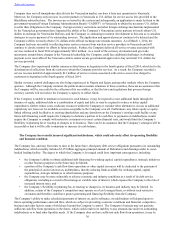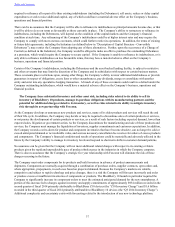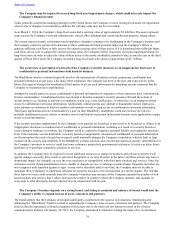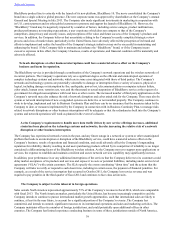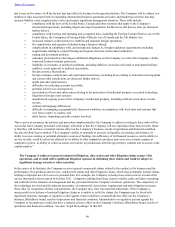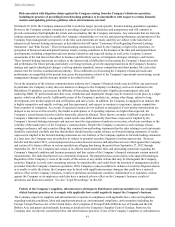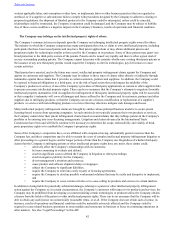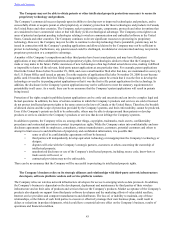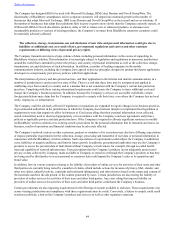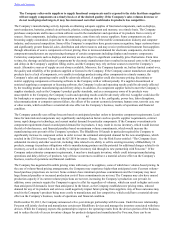Blackberry 2014 Annual Report Download - page 43
Download and view the complete annual report
Please find page 43 of the 2014 Blackberry annual report below. You can navigate through the pages in the report by either clicking on the pages listed below, or by using the keyword search tool below to find specific information within the annual report.
35
were no customers that comprised more than 10% of the Company’s revenue in fiscal 2014 (fiscal 2013 – no customers that
comprised more than 10%; fiscal 2012 – no customers that comprised more than 10%). The Company’s ability to replace or
find new large customers is necessarily limited due to the limited number of wireless carriers and distributors in many
territories.
The Company, in the normal course of business, monitors the financial condition of its customers and reviews the credit history
of each new customer. The Company establishes an allowance for doubtful accounts intended to correspond to the specific
credit risk of its customers, historical trends, and economic circumstances. The Company’s allowances for doubtful accounts
may prove to be inaccurate or insufficient. If the Company experiences significant net bad debts expense for any reason, there
could be a material adverse effect on the Company’s business, results of operations and financial condition.
The Company’s ability to maintain or increase its liquidity, its existing cash balance, its ability to access existing or
potential alternative sources of funding, the sufficiency of its financial resources, and its ability to service its debt,
could be adversely affected by its ability to offer competitive products and services in a timely manner at
competitive prices, its ability to collect accounts receivables in jurisdictions with foreign currency controls and its
access to the capital markets.
As of the end of fiscal 2014, the Company had cash, cash equivalents and investments of approximately $2.7 billion with $1.25
billion in indebtedness as a result of the Debenture Financing. The Company generates cash from sales of its products and
services and investment income to fund its operations and investments. The Company’s working capital requirements and cash
flows historically have been, and are expected to continue to be, subject to quarterly and yearly fluctuations, depending on such
factors as timing and success of new product introductions, levels of sales, returns on the Company’s investment portfolio,
timing of deliveries and collection of receivables, inventory levels, capital expenditures, operating expenses, and customer and
supplier terms and conditions.
The Company’s ability to maintain or increase its cash flow and working capital could be adversely affected if it is unable to
successfully drive adoption of the BlackBerry 10 platform or to enhance service revenues or exploit other opportunities for
generation of revenues. In addition, if the Company fails to accurately predict emerging technological trends and the changing
needs of customers and end users, or the features of its new products and services, including its BlackBerry 10 smartphones do
not meet the expectations or achieve acceptance of its customers, its cash flow, liquidity and financial condition could be
materially harmed. The Company believes that its liquidity position will be strongly influenced by end user adoption of its
BlackBerry 10 platform, by the Company’s ability to sustain the benefits and cost savings achieved through its CORE program
and by its ability to mitigate declining revenues from service access fees.
The Company has, and may from time to time have, third party debt service obligations pursuant to its outstanding
indebtedness, including the Debentures and any drawings under its existing asset-backed lending facility. The Company's
ability to make required payments on this indebtedness depends on its financial and operating performance, which is subject to
prevailing economic and competitive conditions and to certain financial, business, and other factors beyond the Company's
control, including market liquidity conditions, increased operating costs, and trends in the Company's industry. If the
Company's cash flows and capital resources are insufficient to fund these debt service obligations, the Company may be forced
to reduce or delay capital expenditures, sell assets, seek additional capital, or restructure or refinance its indebtedness. In
addition, the terms of any such indebtedness require the Company to meet certain financial tests and impose certain negative
covenants, which may prevent the Company from accessing additional indebtedness or other sources of funding, or pursuing
certain business opportunities and taking certain actions that may be in its interest. There can be no assurance that the credit
facility will continue to be available on its current terms or at all. See also the Risk Factor entitled: “The Company has recently
incurred significant indebtedness, which could adversely affect its operating flexibility and financial condition.”
The Company also conducts business in certain foreign jurisdictions that have legislation or regulations relating to the issuance
of cross-border payments in U.S. dollars, or in other currencies that will exit those countries. Examples of these countries with
foreign currency controls are Venezuela and Argentina, among others. The Company actively manages its exposure in these
jurisdictions based on the existing rules and regulations in place. If the rules or regulations relating to the payment of foreign
currencies in these or other countries change or if the countries devalue their currencies compared to other currencies, the
Company may not be able to collect the amounts owing for the delivery of products and services and this would have a
negative impact on the Company’s cash balance.
The Company continues to have accounts receivables outstanding related to service access fees provided to wireless service
providers in Venezuela that, due to recent political and economic events in that Venezuela (including a significant devaluation
of the Venezuelan Bolivar in 2013), and combined with that country's existing and recently amended foreign currency
restrictions, raise significant uncertainty about the availability of U.S. dollars for the payment of the Company’s invoices. The
Table of Contents


